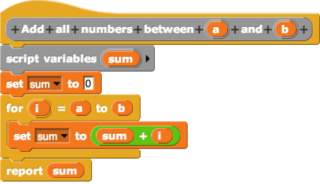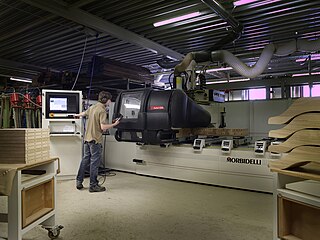Further reading
- ABB Robotics Products AB, RAPID Reference Manual
| Designed by | ABB Group |
|---|---|
| Developer | ABB Group |
| First appeared | 1994 |
| Influenced by | |
| ARLA, C | |
RAPID is a high-level programming language used to control ABB industrial robots. RAPID was introduced along with the S4 Control System in 1994 by ABB, superseding the ARLA programming language.
Features in the language include:
Applesoft BASIC is a dialect of Microsoft BASIC, developed by Marc McDonald and Ric Weiland, supplied with the Apple II series of computers. It supersedes Integer BASIC and is the BASIC in ROM in all Apple II series computers after the original Apple II model. It is also referred to as FP BASIC because of the Apple DOS command used to invoke it, instead of INT for Integer BASIC.
Euphoria is a programming language created by Robert Craig of Rapid Deployment Software in Toronto, Ontario, Canada. Initially developed on the Atari ST, the first commercial release was for MS-DOS as proprietary software. In 2006, with the release of version 3, Euphoria became open-source software. The openEuphoria Group continues to administer and develop the project. In December 2010, the openEuphoria Group released version 4 of openEuphoria along with a new identity and mascot for the project. OpenEuphoria is currently available for Windows, Linux, macOS and three flavors of *BSD.

An industrial robot is a robot system used for manufacturing. Industrial robots are automated, programmable and capable of movement on three or more axes.

Automation describes a wide range of technologies that reduce human intervention in processes, namely by predetermining decision criteria, subprocess relationships, and related actions, as well as embodying those predeterminations in machines. Automation has been achieved by various means including mechanical, hydraulic, pneumatic, electrical, electronic devices, and computers, usually in combination. Complicated systems, such as modern factories, airplanes, and ships typically use combinations of all of these techniques. The benefit of automation includes labor savings, reducing waste, savings in electricity costs, savings in material costs, and improvements to quality, accuracy, and precision.

ABB Ltd. is a Swedish-Swiss multinational corporation headquartered in Västerås, Sweden, and Zürich, Switzerland. The company was formed in 1988 when Sweden's Allmänna Svenska Elektriska Aktiebolaget (Asea) and Switzerland's Brown, Boveri & Cie merged to create Asea Brown Boveri, later simplified to the initials ABB. Both companies were established in the late 1800s and were major electrical equipment manufacturers, a business that ABB remains active in today. The company has also since expanded to robotics and automation technology.
The C standard library or libc is the standard library for the C programming language, as specified in the ISO C standard. Starting from the original ANSI C standard, it was developed at the same time as the C library POSIX specification, which is a superset of it. Since ANSI C was adopted by the International Organization for Standardization, the C standard library is also called the ISO C library.
Delphi is a general-purpose programming language and a software product that uses the Delphi dialect of the Object Pascal programming language and provides an integrated development environment (IDE) for rapid application development of desktop, mobile, web, and console software, currently developed and maintained by Embarcadero Technologies.
BLISS is a system programming language developed at Carnegie Mellon University (CMU) by W. A. Wulf, D. B. Russell, and A. N. Habermann around 1970. It was perhaps the best known system language until C debuted a few years later. Since then, C became popular and common, and BLISS faded into obscurity. When C was in its infancy, a few projects within Bell Labs debated the merits of BLISS vs. C.

In computing, a visual programming language or block coding is a programming language that lets users create programs by manipulating program elements graphically rather than by specifying them textually. A VPL allows programming with visual expressions, spatial arrangements of text and graphic symbols, used either as elements of syntax or secondary notation. For example, many VPLs are based on the idea of "boxes and arrows", where boxes or other screen objects are treated as entities, connected by arrows, lines or arcs which represent relations.

In machining, numerical control, also called computer numerical control (CNC), is the automated control of tools by means of a computer. It is used to operate tools such as drills, lathes, mills, grinders, routers and 3D printers. CNC transforms a piece of material into a specified shape by following coded programmed instructions and without a manual operator directly controlling the machining operation.
In computer science, a call stack is a stack data structure that stores information about the active subroutines of a computer program. This type of stack is also known as an execution stack, program stack, control stack, run-time stack, or machine stack, and is often shortened to simply "the stack". Although maintenance of the call stack is important for the proper functioning of most software, the details are normally hidden and automatic in high-level programming languages. Many computer instruction sets provide special instructions for manipulating stacks.

Robot welding is the use of mechanized programmable tools (robots), which completely automate a welding process by both performing the weld and handling the part. Processes such as gas metal arc welding, while often automated, are not necessarily equivalent to robot welding, since a human operator sometimes prepares the materials to be welded. Robot welding is commonly used for resistance spot welding and arc welding in high production applications, such as the automotive industry.
thinBasic is a BASIC-like computer programming language interpreter with a central core engine architecture surrounded by many specialized modules. Although originally designed mainly for computer automation, thanks to its modular structure it can be used for wide range of tasks.
Robot calibration is a process used to improve the accuracy of robots, particularly industrial robots which are highly repeatable but not accurate. Robot calibration is the process of identifying certain parameters in the kinematic structure of an industrial robot, such as the relative position of robot links. Depending on the type of errors modeled, the calibration can be classified in three different ways. Level-1 calibration only models differences between actual and reported joint displacement values,. Level-2 calibration, also known as kinematic calibration, concerns the entire geometric robot calibration which includes angle offsets and joint lengths. Level-3 calibration, also called a non-kinematic calibration, models errors other than geometric defaults such as stiffness, joint compliance, and friction. Often Level-1 and Level-2 calibration are sufficient for most practical needs.
Robot software is the set of coded commands or instructions that tell a mechanical device and electronic system, known together as a robot, what tasks to perform. Robot software is used to perform autonomous tasks. Many software systems and frameworks have been proposed to make programming robots easier.
Variable Assembly Language (VAL) is a computer-based control system and language designed specifically for use with Unimation Inc. industrial robots.

A robotics simulator is a simulator used to create an application for a physical robot without depending on the physical machine, thus saving cost and time. In some case, such applications can be transferred onto a physical robot without modification.
Natural-language programming (NLP) is an ontology-assisted way of programming in terms of natural-language sentences, e.g. English. A structured document with Content, sections and subsections for explanations of sentences forms a NLP document, which is actually a computer program. Natural language programming is not to be mixed up with natural language interfacing or voice control where a program is first written and then communicated with through natural language using an interface added on. In NLP the functionality of a program is organised only for the definition of the meaning of sentences. For instance, NLP can be used to represent all the knowledge of an autonomous robot. Having done so, its tasks can be scripted by its users so that the robot can execute them autonomously while keeping to prescribed rules of behaviour as determined by the robot's user. Such robots are called transparent robots as their reasoning is transparent to users and this develops trust in robots. Natural language use and natural-language user interfaces include Inform 7, a natural programming language for making interactive fiction, Shakespeare, an esoteric natural programming language in the style of the plays of William Shakespeare, and Wolfram Alpha, a computational knowledge engine, using natural-language input. Some methods for program synthesis are based on natural-language programming.

RoboLogix is a robotics simulator which uses a physics engine to emulate robotics applications. The advantages of using robotics simulation tools such as RoboLogix are that they save time in the design of robotics applications and they can also increase the level of safety associated with robotic equipment since various "what if" scenarios can be tried and tested before the system is activated. RoboLogix provides a platform to teach, test, run, and debug programs that have been written using a five-axis industrial robot in a range of applications and functions. These applications include pick-and-place, palletizing, welding, and painting.
RoboDK is an offline programming and simulation software for industrial robots. The simulation software can be used for many manufacturing projects including milling, welding, pick and place, packaging and labelling, palletizing, painting, robot calibration and more.